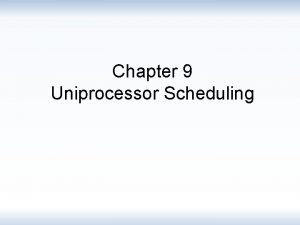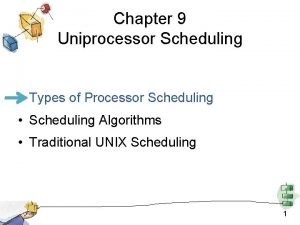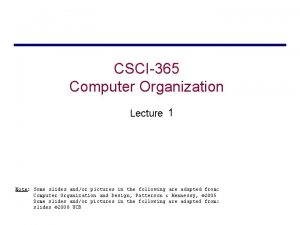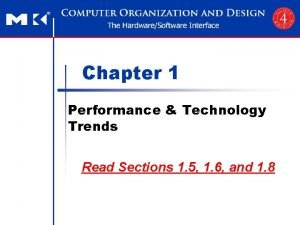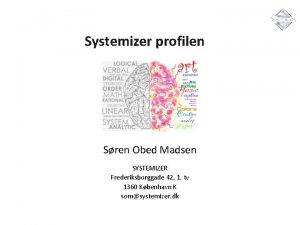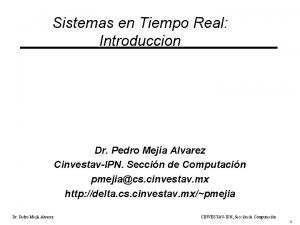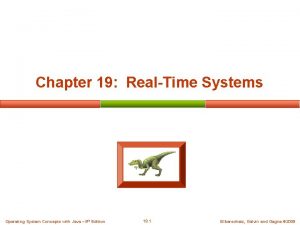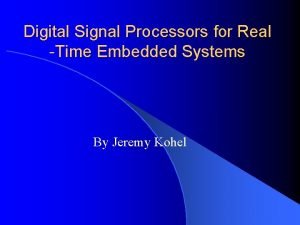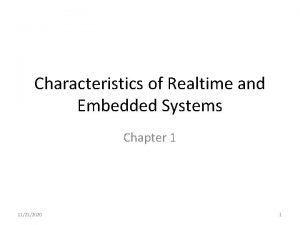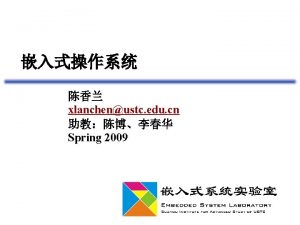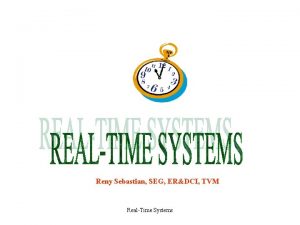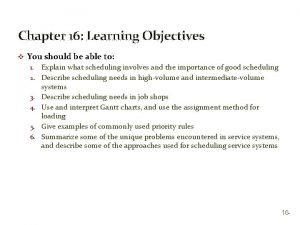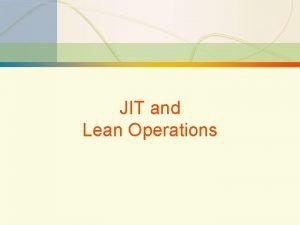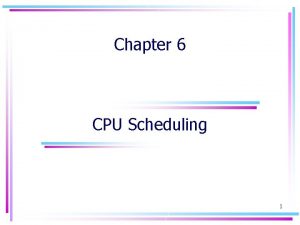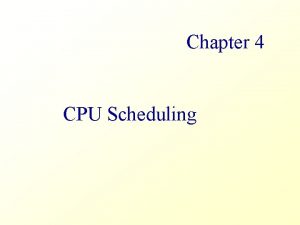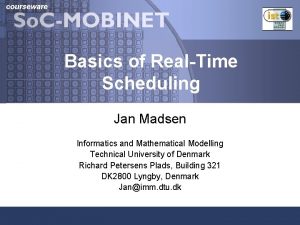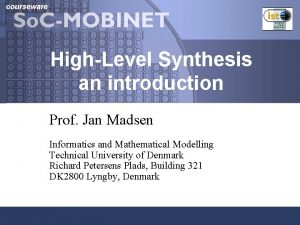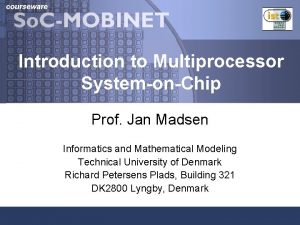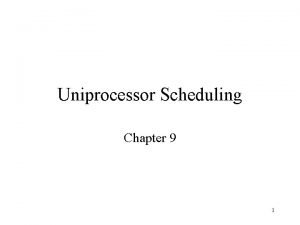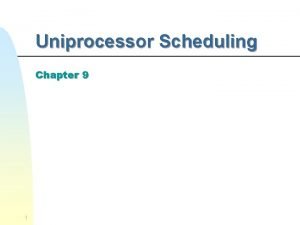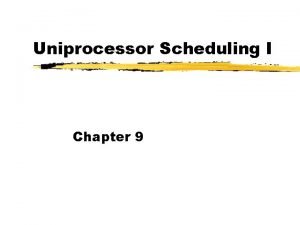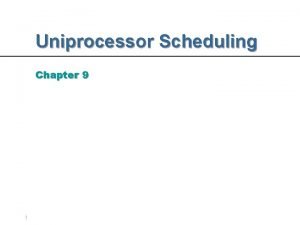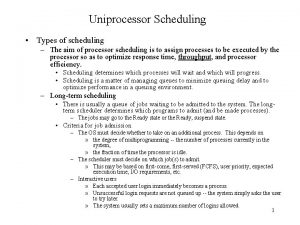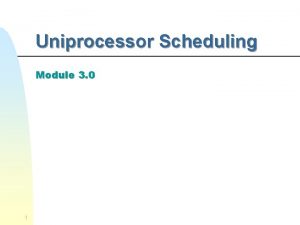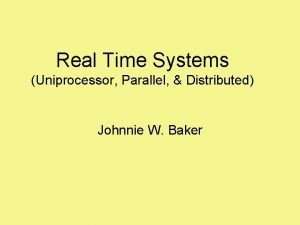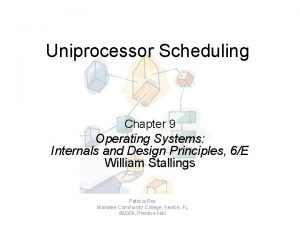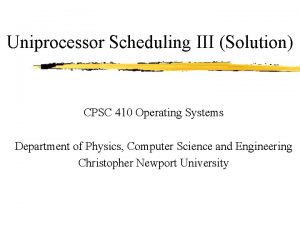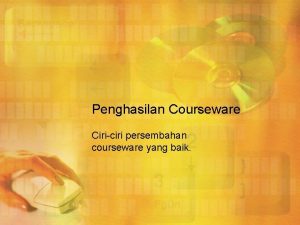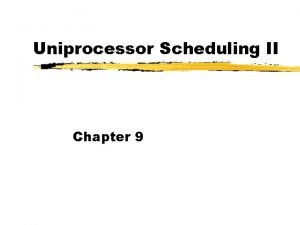courseware Scheduling Uniprocessor Real Time Systems Jan Madsen

![Rate-monotonic scheduling § Real-time scheduling with provable properties [Liu and Layland 73] § Each Rate-monotonic scheduling § Real-time scheduling with provable properties [Liu and Layland 73] § Each](https://slidetodoc.com/presentation_image_h2/79e6f92bddc70e05a325b059c81c7370/image-2.jpg)


























- Slides: 28

courseware Scheduling Uniprocessor Real -Time Systems Jan Madsen Informatics and Mathematical Modelling Technical University of Denmark Richard Petersens Plads, Building 321 DK 2800 Lyngby, Denmark Jan@imm. dtu. dk
![Ratemonotonic scheduling Realtime scheduling with provable properties Liu and Layland 73 Each Rate-monotonic scheduling § Real-time scheduling with provable properties [Liu and Layland 73] § Each](https://slidetodoc.com/presentation_image_h2/79e6f92bddc70e05a325b059c81c7370/image-2.jpg)
Rate-monotonic scheduling § Real-time scheduling with provable properties [Liu and Layland 73] § Each process is independent and given a unique priority § A process may be preempted by a higher-priority process § All processes have a deadline equal to their period and a fixed WCET § Context switching overhead is ignored So. C-MOBINET courseware Jan Madsen 2

RMS pi ai si ci pi di = T i The critical instance for a process occurs when the process and all higher-priority processes are released simultaneously Must guarantee that all processes meet their deadlines, independent of order of releases So. C-MOBINET courseware Jan Madsen 3

RMS example Ti Ci p 1 50 12 p 2 40 10 p 3 30 10 50 p 1 40 p 2 30 p 3 0 10 So. C-MOBINET courseware 20 Jan Madsen 30 40 50 60 4

Rate-monotonic priority assignment § Each process is given a unique priority where 1 is the highest § Prioritize according to Ti’s, with shortest-period process given highest priority § Fixed-priority scheme § Independent of ci’s § This priority assignment is optimal No fixed priority scheme does it better! So. C-MOBINET courseware Jan Madsen 5

RMS example (cont. ) So. C-MOBINET courseware Ti Ci priority p 1 50 12 3 p 2 40 10 2 p 3 30 10 1 Jan Madsen 6

CPU utilization under RMS § Given N independent processes, utilization U N ci U =å i =1 Ti • Least upper bound for utilization U < N(21 N - 1) 1 N lim ( N ( 2 ®¥ N So. C-MOBINET courseware - 1) = 69. 3% Jan Madsen 7

RMS example (cont. ) Ti Ci priority U p 1 50 12 1 0. 24 p 2 40 10 2 0. 25 p 3 30 10 3 0. 33 0. 82 13 < ( U 3 2 - 1) = 0. 78 So. C-MOBINET courseware Jan Madsen 8

RMS example (cont. ) 50 p 1 40 p 2 30 p 3 0 10 So. C-MOBINET courseware 20 Jan Madsen 30 40 50 60 9

RMS § The utilization-based schedulability test is sufficient but not necessary § If the test is passed it is schedulable § If the test is not passed, it may be schedulable § If all processes meet their first deadline then they will meet all future one So. C-MOBINET courseware Jan Madsen 10

Response time analysis § Highest-priority process r=c § Other processes will suffer interference from higher-priority processes ri = c i + i i § Maximum interference occur at a critical instance So. C-MOBINET courseware Jan Madsen 11

Response time analysis number of releases of process pj during [0, Ri ) é Riù Ri = ci + å ê ú cj T j Î hp (i ) ê jú each release will impose an interference of cj Processes with higher-priority than pi n é ù w n +1 wi = ci+ Îå ê iú cj j hp( i ) ê ê Tj úú So. C-MOBINET courseware Jan Madsen 12

Response time analysis example w 10 w 20 =3 R 1=3 =3 w 2 éê 3 ùú 3+ 3=6 êê 7 úú w 2 éê 6 ùú 3+ 3=6 êê 7 úú 1 = 2 = So. C-MOBINET courseware Jan Madsen Ti Ci priority p 1 7 3 1 p 2 12 3 2 p 3 20 5 3 R 2=6 13

Earliest-Deadline-First Scheduling § Dynamic priority scheme § changes priorities during execution based on initiation times § can achieve higher CPU utilization than RMS, i. e. 100% § Priority policy: § process with closest deadline gets highest-priority So. C-MOBINET courseware Jan Madsen 14

EDF example p 1 p 2 p 3 Ti Ci p 1 3 1 p 2 4 1 p 3 5 2 1 3 2 2 1 2 1 3 3 2 1 2 3 2 1 1 3 3 3 0 1 2 So. C-MOBINET courseware 3 4 5 Jan Madsen 6 7 8 9 10 12 13 14 15 16 15

RMS example Ti Ci p 1 50 12 p 2 40 10 p 3 30 10 50 p 1 40 p 2 30 p 3 0 10 So. C-MOBINET courseware 20 Jan Madsen 30 40 50 60 16

RMS example scheduled using EDF Ti Ci p 1 50 12 p 2 40 10 p 3 30 10 50 p 1 40 p 2 30 p 3 0 10 20 So. C-MOBINET courseware 30 40 Jan Madsen 50 60 70 80 90 100 110 17

Comparing RMS and EDF § Higher CPU utilization with EDF § Easier to ensure that deadlines will be satisfied with RMS § RMS easier to implement So. C-MOBINET courseware Jan Madsen 18

Overload conditions § When not all processes can meet their deadlines § EDF may result in domino effect § First process missing its deadline may cause all subsequent processes to miss their deadlines § Accociate value wi of importance with each process § Use Ti/wi as priority (similar to shortest-process-first) So. C-MOBINET courseware Jan Madsen 19

More realistic model assumptions § § § Shared resources Data dependencies Context switching Cache effects Power reduction So. C-MOBINET courseware Jan Madsen 20

Shared resources § Scheduling processes without considering resource requirements may cause priority inversion § example, p 1 highest-priority process p 1{r 1} deadlock! p 2 {r 1} So. C-MOBINET courseware Jan Madsen 21

Shared resources § When there are mutual exclusion constraints, it is impossible to find a totally on-line optimal runtime scheduler [Mok 83] § Priority ceiling protocol (PCP) § a way to bound priority inversion § blocking of processes that may cause them § temporary priority increase of process § PCP prevents deadlocks So. C-MOBINET courseware Jan Madsen 22

Data dependencies t 1 t 2 di p 1 p 3 p 2 ci t 1 10 p 1 2 t 2 8 p 2 1 p 3 4 p 1 p 2 p 3 So. C-MOBINET courseware Jan Madsen 23

Context switching ci di p 1 3 5 p 2 2 10 p 1 p 2 0 2 4 So. C-MOBINET courseware 6 8 Jan Madsen 10 0 2 4 6 8 10 24

Cache effects cache policy: least-recently-used p 1 ci average ci p 1 2 1. 5 p 2 1 0. 75 p 3 1 0. 75 p 2 p 3 LRU p 1 So. C-MOBINET courseware p 2 p 1 p 3 p 2 Jan Madsen p 1 p 3 p 2 25

Cache effects cache policy: keep p 1 in cache p 1 ci average ci p 1 2 1. 5 p 2 1 0. 75 p 3 1 0. 75 p 2 p 3 p 1 So. C-MOBINET courseware p 2 p 1 p 3 p 1 Jan Madsen p 3 p 1 p 2 p 1 p 3 p 1 26

Power reduction § Power management policy § Takes time to power-down/up § Techniques: § event/request based § predictive § probabilistic So. C-MOBINET courseware Jan Madsen 27

Power reduction p 1 r 1 p 2 p 3 r 1 idle p 1 r 1 idle r 1 p 2 p 3 r 1 idle So. C-MOBINET courseware Jan Madsen 28
 Uniprocessor scheduling in os
Uniprocessor scheduling in os Scheduling formula
Scheduling formula Parallelism in uniprocessor system
Parallelism in uniprocessor system Uniprocessor
Uniprocessor Uniprocessor
Uniprocessor 2013 cci learning
2013 cci learning Soft skills courseware
Soft skills courseware Win courseware
Win courseware Neil beidleman
Neil beidleman Mama tataba
Mama tataba Lorna wings triade
Lorna wings triade Charlotte brønsted
Charlotte brønsted Bent madsen dynamiske omsorgsmodel
Bent madsen dynamiske omsorgsmodel Sjn scheduling
Sjn scheduling Sensor and (tiempo real or real time)
Sensor and (tiempo real or real time) Real-time systems and programming languages
Real-time systems and programming languages Real-time operating systems
Real-time operating systems Dsp in embedded system
Dsp in embedded system Embedded systems characteristics
Embedded systems characteristics Real-time executive for multiprocessor systems
Real-time executive for multiprocessor systems Real-time systems and programming languages
Real-time systems and programming languages Real time systems
Real time systems Real time characteristics of embedded operating systems
Real time characteristics of embedded operating systems Scheduling in high-volume systems is known by what term?
Scheduling in high-volume systems is known by what term? Jit inventory
Jit inventory Example of elapsed time
Example of elapsed time Seek time rotational delay and transfer time
Seek time rotational delay and transfer time Shortest remaining time first scheduling
Shortest remaining time first scheduling In cpu scheduling the clock is of type
In cpu scheduling the clock is of type
